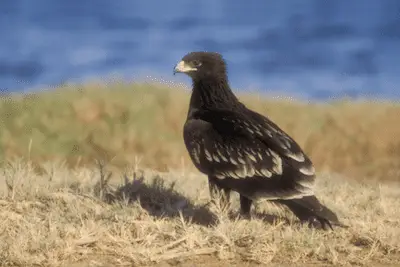Greater Spotted Eagle
(Clanga clanga)
The Greater Spotted Eagle is currently one of the rarest European raptors, with less than 1,000 pairs estimated to be breeding in Europe.

Also, out of the total population of Greater Spotted Eagles in Europe, less than 100 breeding are estimated to occur outside of the European part of Russia, which puts this eagle species dangerously close to extinction throughout most of Europe.
Similar to the Golden Eagle, Greater Spotted Eagles prefer to nest far away from human settlements, but unfortunately their habitat preference is for lowland deciduous forest, which rarely exists far away from human population centers in Europe.
So in order to save the Greater Spotted Eagle in Europe it is essential to create new habitats and sanctuaries where this rare raptor can breed undisturbed by human activity.
Greater Spotted Eagle facts
The Greater Spotted Eagle is specialized in foraging around bodies of water and wetlands, where it feeds predominantly on small vertebrate species that occur in this habitat.
Greater Spotted Eagle size
As a medium sized eagle, the Greater Spotted Eagle is bigger than a Common Buzzard, but smaller than a Golden Eagle.
- Greater Spotted Eagle wingspan: 160-183 cm
- Length: 63-75 cm
- Weight: 1,750-3,100 g (female), 1,600-2,000 g (male)
The Greater Spotted Eagle is most likely to be confused with its close cousin the Lesser Spotted Eagle. When in doubt, the Greater Spotted Eagle is slightly larger, darker, and heavier than the Lesser Spotted Eagle.
Appearance
The overall appearance of the Greater Spotted Eagle is that of a large dark raptor with long wings. Compared to other eagle species belonging to the genus Aquila, it has a shorter tail compared to the length of its wings.

Adults have characteristic white markings on top that look like white spots, and hence explain its name.
Sexual dimorphism
Just as is the case with most raptor species living in Europe, the female Greater Spotted Eagle is significantly larger than its male counterpart.
Scientific name and taxonomy
The scientific name of the Greater Spotted Eagle is Clanga clanga. It was previously classified as part of the genus Aquila, which comprises the true eagles, but DNA analysis showed that it is actually in a separate clade with two other species of Spotted Eagles, including the Lesser Spotted Eagle (Clanga pomarina) in Europe.
Greater Spotted Eagle distribution
Breeds in eastern Europe with its range extending eastwards from there all the way to Siberia and China. As mentioned earlier, most European breeding locations only have a handful of pairs, and overall the westernmost edge of the distribution of Greater Spotted Eagles has been shrinking.
Greater Spotted Eagle habitat
The Greater Spotted Eagle prefers deciduous forests mixed with open land that has plenty of wetland, open water, and marshes in the mix. Unfortunately, it is difficult to find large extents of this kind of habitat secluded from human settlements in Europe, which explains why the Greater Spotted Eagle has been on the decline for decades.
Greater Spotted Eagle population size
The total population size of the Greater Spotted Eagle in Europe is estimated to be between 900 and 1,100 pairs, with the majority occurring in the European part of Russia (600-800 pairs). After Russia, Belarus has the biggest population with 150-200 pairs, while all other European countries have just a handful of pairs each.
Greater Spotted Eagle behavior
Hunts in open country, either by soaring or slowly flying at medium height above the ground (a technique known as “quartering”). It also still-hunts from a perch, similar to buzzard species, and even hunts on foot.
Feeding and diet
The main food source of Greater Spotted Eagles in their breeding habitat are Water Voles in many locations, as well as hamsters and susliks in other locations.
In addition to small mammals it also takes waterfowl, including ducks, coots, and rails, that it usually takes on the water. Finally, reptiles and amphibians also play a role in its diet. Outside of the breeding season, the Greater Spotted Eagle also feeds on carrion.
Breeding
The Greater Spotted Eagle builds its nest on deciduous trees. The female lays 1-3 eggs, which are incubated for up to 43 days. After hatching the young eagles stay in the nest for up to 68 days, and continue to be fed after leaving the nest.
As with many other large eagle species in Europe, the oldest chick of the Greater Spotted Eagle often kills its younger sibling(s), although this doesn’t occur all the time, and sometimes 2 young eagles are raised successfully.
Migration
A strict migratory species, the Greater Spotted Eagle spends its winter in north-eastern Africa and the Middle East, while a few birds also winter in Turkey and Greece. Rare winter sightings in France and Italy are also reported.
Greater Spotted Eagle conservation status
The Greater Spotted Eagle is one of the most vulnerable raptors in Europe, which is currently in decline in the westernmost part of its range. And while it has a relatively large distribution, it doesn’t have a high population density in most areas, which means that local populations are very vulnerable to adverse events. Because of this, the Greater Spotted Eagle is classified as “Vulnerable” by BirdLife International.
Threats
The main threat to the Greater Spotted Eagle in Europe is destruction of habitat, because most lowland areas have become cultivated, drained, or otherwise reshaped by human activities. It requires a complex set of habitats, including large ranges of wetland coupled with old deciduous forest that is undisturbed during its nesting season. Providing this mix of habitats is challenging in highly cultivated landscapes, but doing so will also benefit countless other species.
Additional resources:
- Booted Eagle habitat and distribution
- Short-toed Eagle migration patterns
- Steppe Eagle conservation status
